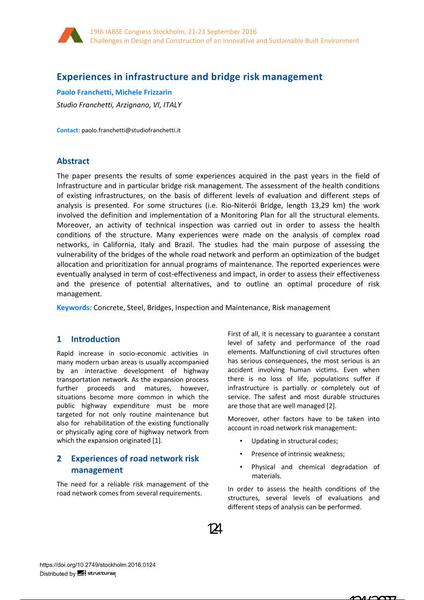Experiences in infrastructure and bridge risk management

|
|
|||||||||||
Bibliografische Angaben
| Autor(en): |
Paolo Franchetti
(Studio Franchetti, Arzignano, VI, ITALY)
Michele Frizzarin (Studio Franchetti, Arzignano, VI, ITALY) |
||||
|---|---|---|---|---|---|
| Medium: | Tagungsbeitrag | ||||
| Sprache(n): | Englisch | ||||
| Tagung: | IABSE Congress: Challenges in Design and Construction of an Innovative and Sustainable Built Environment, Stockholm, Sweden, 21-23 September 2016 | ||||
| Veröffentlicht in: | IABSE Congress Stockholm, 2016 | ||||
|
|||||
| Seite(n): | 124-131 | ||||
| Anzahl der Seiten (im PDF): | 8 | ||||
| Jahr: | 2016 | ||||
| DOI: | 10.2749/stockholm.2016.0124 | ||||
| Abstrakt: |
The paper presents the results of some experiences acquired in the past years in the field of Infrastructure and in particular bridge risk management. The assessment of the health conditions of existing infrastructures, on the basis of different levels of evaluation and different steps of analysis is presented. For some structures (i.e. Rio-Niterói Bridge, length 13,29 km) the work involved the definition and implementation of a Monitoring Plan for all the structural elements. Moreover, an activity of technical inspection was carried out in order to assess the health conditions of the structure. Many experiences were made on the analysis of complex road networks, in California, Italy and Brazil. The studies had the main purpose of assessing the vulnerability of the bridges of the whole road network and perform an optimization of the budget allocation and prioritization for annual programs of maintenance. The reported experiences were eventually analysed in term of cost-effectiveness and impact, in order to assess their effectiveness and the presence of potential alternatives, and to outline an optimal procedure of risk management. |
||||
| Stichwörter: |
Stahl Beton Brücken Risikomanagement
|
||||
